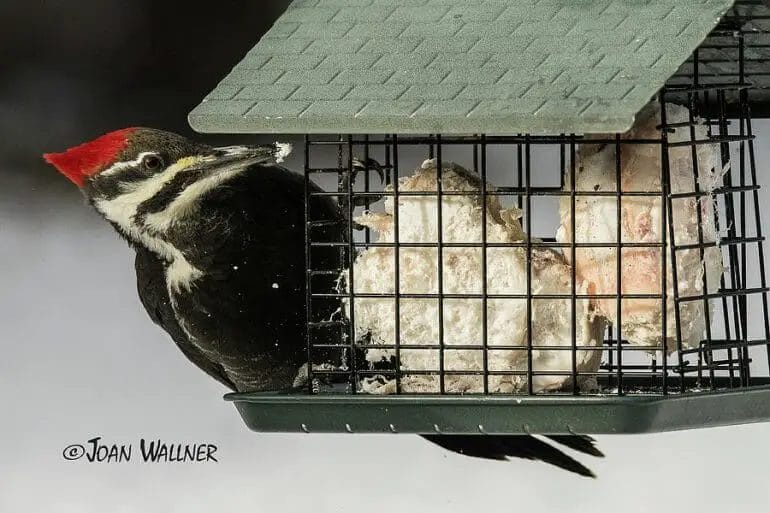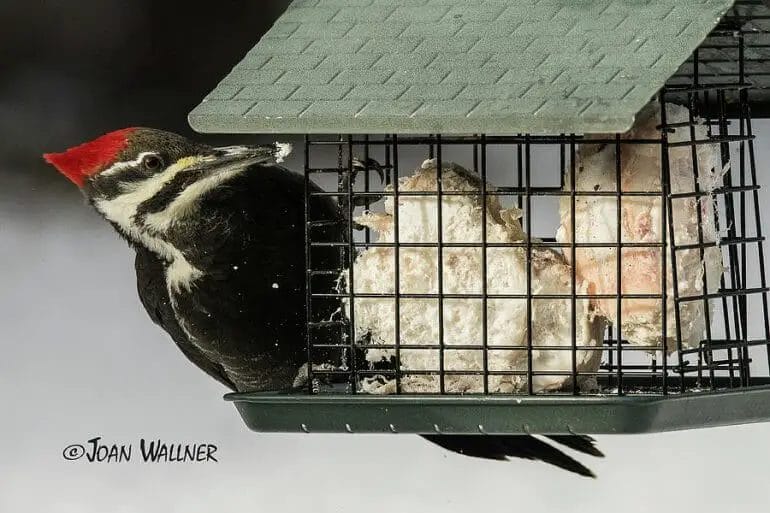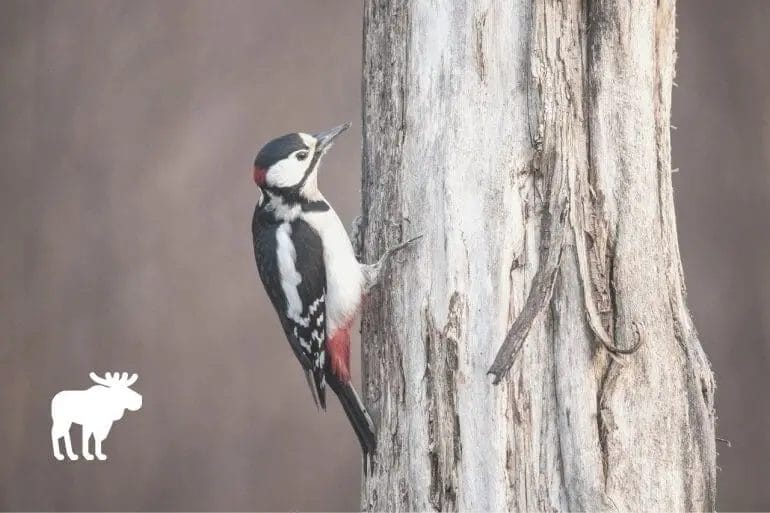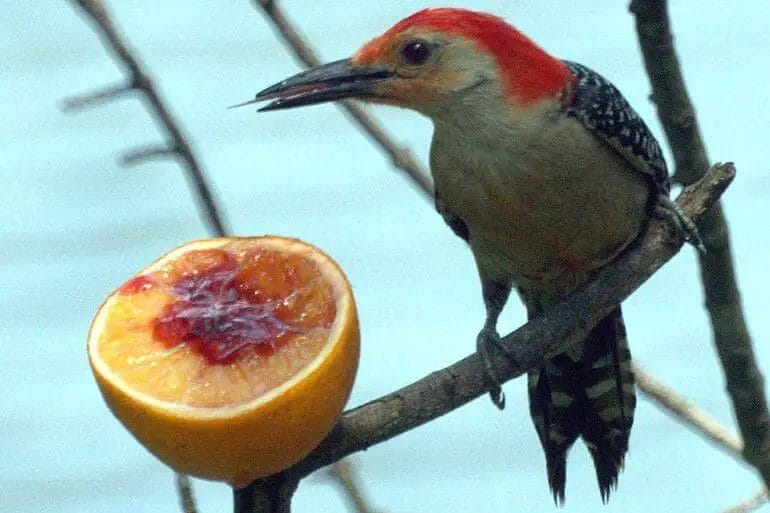Yes, woodpeckers do eat wood as a part of their diet. However, it may not be in the way you think. Woodpeckers do not actually consume the wood, but rather peck on trees to find insects hiding beneath the bark. These birds have strong beaks and long tongues that allow them to extract insects, larvae, and other small prey from the wood. They play an important role in controlling insect populations and are fascinating creatures to observe in nature.

Types of Woodpecker Food: Exploring the Variety in a Woodpecker’s Diet
Woodpeckers are fascinating birds known for their distinctive behavior of drumming on trees with their beaks. While this behavior might seem peculiar, it serves a purpose beyond making noise. Woodpeckers drum on trees to locate food hidden within the bark, such as insects, larvae, and other small creatures.

Woodpeckers have a diverse diet that consists of various types of food. Let’s delve into the different types of food that woodpeckers consume:
1. Insects and Larvae
A significant portion of a woodpecker’s diet consists of insects and their larvae. Woodpeckers have specially adapted beaks that allow them to drill into the bark of trees to extract these tasty morsels. They primarily target wood-boring insects, such as beetles, ants, termites, and caterpillars. This ability to find and feed on insects plays a crucial role in controlling pest populations in forests and other habitats.
2. Tree Sap
Woodpeckers are also known to feed on tree sap. They have a unique adaptation called a “tongue barb,” which helps them extract sap from trees. The sap provides a source of energy and nutrients for the woodpeckers. They often create sap wells by repeatedly pecking at certain areas of the tree, allowing the sap to flow out, which they then consume.
3. Fruits and Berries
Although insects and sap are the primary sources of food for woodpeckers, they also include fruits and berries in their diet. As opportunistic feeders, woodpeckers take advantage of the seasonal abundance of fruits and berries. They may feed on apples, cherries, elderberries, and other similar food sources when available. This variety helps supplement their diet during times when insects or sap may be scarce.
4. Nuts and Seeds
Woodpeckers are not solely reliant on insects and sap for sustenance. They also consume nuts and seeds as part of their diet. Acorns, pine nuts, and sunflower seeds are among their preferred choices. Woodpeckers are known for their role in seed dispersal, as they may store nuts and seeds in tree crevices or the ground, contributing to the growth of new plants in their habitat.
5. Eggs and Nestlings
While it may seem surprising, woodpeckers are occasionally known to prey on eggs and nestlings of other bird species. This behavior is more common during the breeding season when woodpeckers require additional protein to support their own chicks. However, this behavior is not typical for all woodpecker species and varies depending on environmental factors and food availability.
In summary, woodpeckers have a diverse diet that includes insects, larvae, tree sap, fruits, berries, nuts, seeds, and occasionally eggs and nestlings. Their ability to adapt to different food sources allows them to thrive in various habitats, contributing to the overall balance of ecosystems. So, the next time you hear the distinctive drumming of a woodpecker, remember the wide range of food it relies on to survive.

Woodpecker Feeding Habits: How and Where Do Woodpeckers Find Their Food?
Woodpeckers are fascinating birds that belong to the family Picidae. They are known for their unique feeding habits and ability to extract insects and larvae from trees. In this section, we will explore how and where woodpeckers find their food.
1. Foraging Techniques:
Woodpeckers have developed several ingenious techniques to locate and extract their food. Some of the common foraging techniques used by woodpeckers include:
- Drumming: Woodpeckers use their strong bills to drum on tree trunks. This drumming behavior serves two purposes – it helps the woodpecker establish its territory and also locate the presence of insects in the wood.
- Probing: Woodpeckers use their long, sticky tongues to probe deep into crevices in trees. They can feel the vibrations caused by insects and larvae and use their tongues to extract them.
- Chiseling: Woodpeckers often chisel away at the bark of trees to create cavities. These cavities not only serve as nesting sites but also provide access to insects hiding beneath the bark.
2. Food Sources:
Woodpeckers have a diverse diet that primarily consists of insects, larvae, and tree sap. Let’s take a look at some of their common food sources:
- Insects: Woodpeckers feed on a wide variety of insects, including ants, beetles, termites, and caterpillars. They can detect wood-boring insects by listening to the sounds they make inside trees.
- Larvae: Many woodpeckers specialize in extracting the larvae of wood-boring insects. They locate the larvae by drumming on trees and listening for the movement of the larvae inside.
- Tree Sap: Some woodpeckers feed on the sap of trees, particularly during the winter months when insects may be scarce. They create small holes in the bark and extract the sugary sap.
- Fruits and Nuts: In addition to insects, woodpeckers also consume fruits and nuts. This is especially true during the non-breeding season when insects may be less abundant.
3. Preferred Habitat:
Woodpeckers can be found in various habitats, including forests, woodlands, and even urban areas with mature trees. However, they do have some preferences when it comes to their habitat:
- Tree Availability: Woodpeckers require trees as a food source and for nesting. They are more commonly found in areas with a dense concentration of trees.
- Dead or Decaying Trees: Woodpeckers are often attracted to dead or decaying trees as they provide an abundant supply of insects and larvae.
- Mature Forests: Many woodpecker species prefer mature forests with a mixture of tree species. These forests offer a diverse range of food sources.
In summary, woodpeckers have unique foraging techniques and a varied diet consisting of insects, larvae, tree sap, fruits, and nuts. They can be found in a range of habitats, but they have a preference for areas with an abundance of trees and dead or decaying wood. Understanding their feeding habits helps us appreciate these remarkable birds and the important role they play in our ecosystems.

The Role of Insects in a Woodpecker’s Diet: Why Woodpeckers Rely on More Than Just Wood
Woodpeckers are fascinating birds known for their unique behavior of drumming on trees with their beaks. While it’s true that woodpeckers derive a significant portion of their diet from wood, insects also play a crucial role in their survival. In this section, we will explore the importance of insects in a woodpecker’s diet and how they contribute to their overall health and well-being.
1. Nutritional Benefits:
Insects provide essential nutrients that woodpeckers need to thrive. They are a rich source of protein, fats, and minerals, which are vital for the bird’s growth, energy production, and overall health. Woodpeckers rely on insects to meet their nutritional requirements and maintain their high metabolism.
2. Abundance of Prey:
Woodpeckers are excellent hunters and have adapted to forage for insects residing within the tree bark. Insects, such as beetles, ants, and termites, inhabit dead or decaying wood, where they become easy targets for woodpeckers. These birds have specialized tongues with barbed tips that help extract insects from crevices with precision.
3. Sustained Energy:
Woodpeckers are highly active birds that require a constant supply of energy throughout the day. Insects provide a readily available source of energy due to their high caloric content. Foraging for insects allows woodpeckers to replenish their energy levels quickly, enabling them to continue their vigorous drumming and other physical activities.
4. Prey Diversity:
While woodpeckers primarily feed on wood-boring insects, they also consume a variety of other insect species. This diversity in prey helps ensure a balanced diet and reduces the risk of nutritional deficiencies. Woodpeckers are opportunistic feeders and will target different types of insects depending on their availability and seasonality.
5. Nesting and Reproduction:
Insects play a crucial role during the nesting and reproduction phase of woodpeckers. Female woodpeckers require a substantial amount of protein-rich food to produce eggs and raise their young. By feeding on insects, woodpeckers ensure the availability of vital nutrients for successful reproduction and the healthy development of their offspring.
6. Pest Control:
Woodpeckers also provide a valuable service by controlling insect populations that could otherwise cause damage to trees and forests. By selectively foraging on wood-boring insects, they help prevent the spread of pests and limit the risk of infestations. This symbiotic relationship benefits both the woodpeckers and the ecosystem they inhabit.
7. Adaptability:
Woodpeckers are highly adaptable birds that can adjust their foraging techniques based on the availability of food sources. Insects serve as a crucial backup food supply for woodpeckers when their primary food source, wood, is scarce or unavailable. This adaptability enhances their chances of survival and resilience in challenging environments.
In summary, while wood is a significant component of a woodpecker’s diet, insects play a vital role in their overall nutrition, energy requirements, reproduction, and ecosystem balance. Understanding the importance of insects in a woodpecker’s diet helps us appreciate the complex relationship between these fascinating birds and their environment.
Woodpecker Adaptations
Woodpeckers are fascinating birds known for their ability to extract food from trees by pecking. They have developed several incredible adaptations that allow them to do this without harming themselves. Let’s explore some of these adaptations:
- Strong Beaks: Woodpeckers have strong, chisel-like beaks specifically designed for pecking. Their beaks are long and sharp, allowing them to drill into tree bark with ease. The beak acts as a powerful tool for extracting insects and grubs hiding within the tree.
- Shock Absorption: The act of pecking trees repeatedly can generate enormous forces. To protect their brains from the impact, woodpeckers have evolved a specialized shock absorption system. The hyoid bone, located at the base of their skull, acts as a shock absorber and prevents any damage to their brain.
- Barbed Tongue: Woodpeckers possess a unique tongue structure that aids them in extracting food. Their tongues are long, sticky, and have barbs at the ends. These barbs help them snatch insects and grubs from deep within tree crevices. Additionally, the tongue can extend far beyond the beak, allowing woodpeckers to reach inaccessible food sources.
- Stiff Tail Feathers: Another adaptation that helps woodpeckers maintain balance and stability while pecking is their stiff tail feathers. These feathers act as a prop, providing support and allowing them to cling to vertical surfaces. This stability enables woodpeckers to focus on extracting food without the fear of falling.
- Cushioned Skull: Pecking can create significant impact forces, but woodpeckers have a unique way of protecting their brain. Their skull features a spongy bone structure and is equipped with a cushioning layer of cartilage. These adaptations absorb the impact, preventing brain injury.
- Protective Eyelids: Woodpeckers have a third eyelid called a nictitating membrane that covers their eyes while pecking. This membrane acts as a shield, preventing debris from entering their eyes and protecting them from potential damage during the pecking process.
- Powerful Neck Muscles: Woodpeckers have exceptionally strong neck muscles that allow them to rapidly peck at a tree. These muscles provide the necessary force for drilling and extracting food. The muscles are so robust that they can withstand the repetitive pecking motion without strain or injury.
These remarkable adaptations enable woodpeckers to extract food from trees efficiently and without harming themselves. Their specialized beaks, shock absorption system, barbed tongues, stiff tail feathers, cushioned skulls, protective eyelids, and powerful neck muscles all work together to make them highly efficient foragers in their natural habitat.
FAQs
1. Does a woodpecker eat wood?
Yes, woodpeckers do eat wood. However, they don’t actually consume the wood itself. They peck on trees to find insects hiding inside the wood, which is their primary source of food. Woodpeckers have specially adapted beaks and tongues to help them extract insects from trees.
Conclusion:
In conclusion, woodpeckers are fascinating birds known for their unique feeding habit of consuming wood. These birds have adapted to their environment by developing strong beaks and specialized tongues to extract insects and larvae from tree bark. While woodpeckers eat wood, their diet also includes insects, fruits, and seeds, providing them with a well-rounded source of nutrients. Their ability to feed on wood helps control insect populations and supports healthy forest ecosystems. With their distinct drumming sounds and vibrant plumage, woodpeckers are not only important contributors to nature but also a delight to observe in the wild.